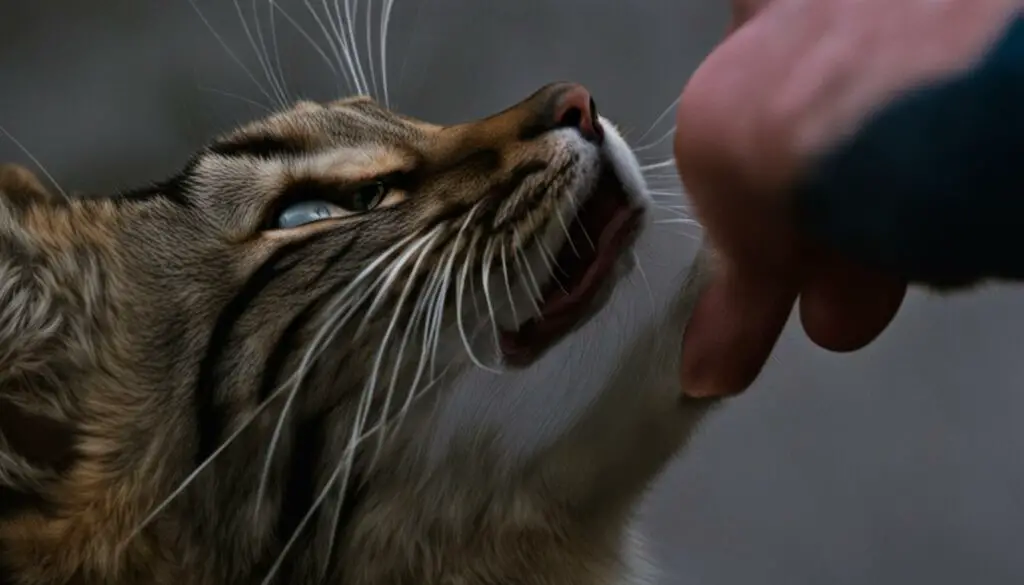Cat owners often wonder why their cats bite them when they stop petting them. This behavior is not uncommon and is often not a sign of true aggression. Understanding the reasons behind this behavior can help cat owners avoid it and better interpret their cat’s subtle signals.
Key Takeaways:
- It’s important to recognize that cat biting when petting stops is not necessarily aggressive behavior.
- Kittens engage in biting behavior as part of their play and learning process.
- Cats may use play biting to communicate and mimic hunting behaviors.
- Some cats may gently nibble or bite their owners as a sign of affection.
- Aggressive biting is a more serious form of biting and may be accompanied by defensive body language.
Kitten Biting
Kittens, adorable and playful as they are, tend to engage in biting behavior as part of their natural development. This behavior is their way of exploring the world, practicing their hunting skills, and relieving teething discomfort. While it may be frustrating for owners, it’s important to understand that biting is a normal part of their play and learning process.
Providing appropriate toys and playtime is crucial in redirecting their biting behavior. Interactive toys that mimic prey, such as feather wands or stuffed mice, can help satisfy their natural hunting instincts. Additionally, encouraging playtime with other kittens or gentle, supervised play with humans can teach them appropriate boundaries. If a kitten does bite during play, it’s important to avoid reacting with aggression or punishment, as this may confuse or frighten them.
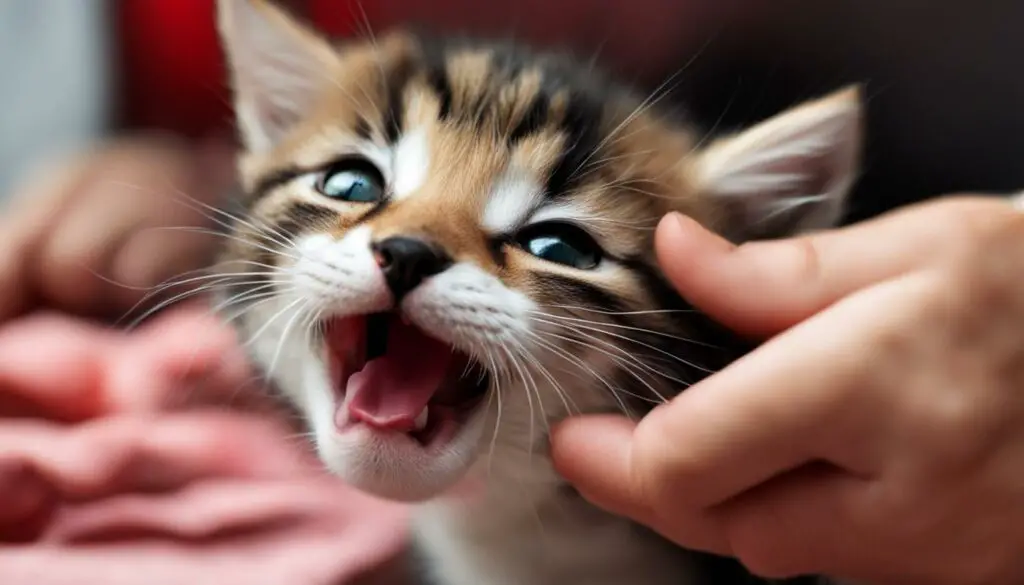
When a kitten bites, it’s essential to redirect their attention to a more appropriate target, such as a toy or a scratching post. By consistently redirecting their behavior and rewarding them with praise or treats for appropriate play, kittens can learn that biting humans is not acceptable.
| Why Kittens Bite | How to Address It |
|---|---|
| Exploring their environment | Provide appropriate toys and play opportunities |
| Practicing hunting skills | Use interactive toys that mimic prey |
| Relieving teething discomfort | Provide teething toys or chilled damp towels |
“Kittens biting during play is a natural behavior, and redirecting their attention to appropriate toys can help teach them boundaries.” – Cat Behavior Expert
By understanding and addressing kittens’ biting behavior, owners can foster a safe and enjoyable environment for both the kitten and themselves. Consistency, patience, and positive reinforcement are key in guiding kittens towards appropriate play and minimizing unwanted biting.
Play Biting
Cats are known for their playful nature, and play biting is a common behavior that both kittens and adult cats engage in. Play biting serves multiple purposes for cats, including communication and practicing their hunting skills. It’s important for cat owners to understand this behavior and provide appropriate outlets for their cat’s play instincts.
When cats engage in play biting, they are often mimicking hunting behaviors. By engaging in mock bites, cats are honing their hunting skills and satisfying their natural instincts. This behavior also serves as a form of communication between cats, as they use play biting to establish boundaries and convey their intentions.
To prevent play biting from being directed towards humans, it’s crucial for cat owners to provide stimulating play opportunities and appropriate toys. Interactive toys that mimic prey, such as feather wands or laser pointers, can redirect the cat’s hunting instincts away from human hands. Ensuring regular play sessions not only helps satisfy their hunting skills but also provides mental and physical stimulation for a happy and well-adjusted cat.
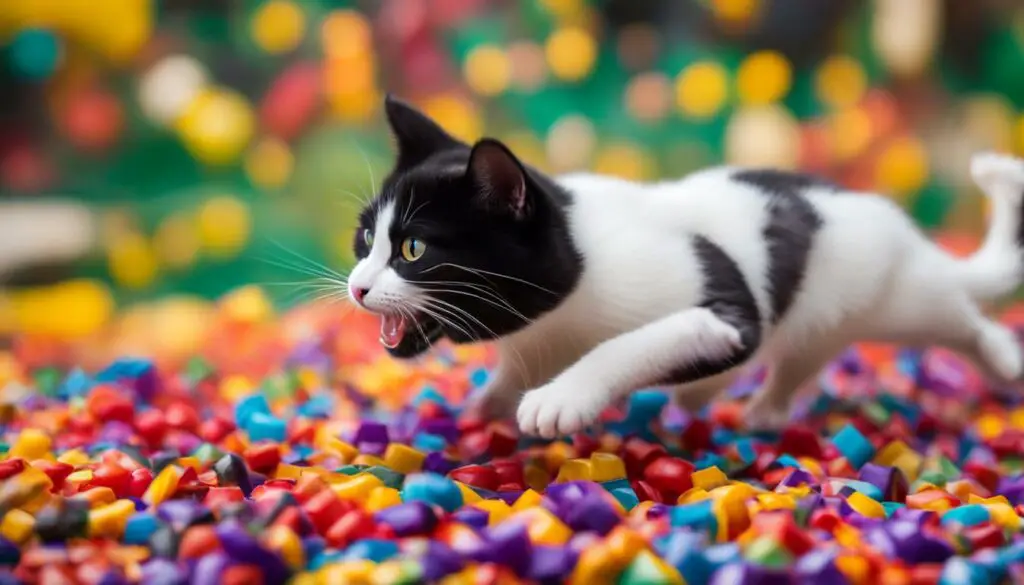
Note: Play biting is a healthy and normal behavior for cats. However, it’s important to differentiate between play biting and aggressive biting. If your cat’s play biting becomes aggressive or causes injury, it’s recommended to seek guidance from a qualified feline behaviorist to address any underlying issues.
Sudden Biting When Petting
Have you ever been surprised when your cat suddenly bites you while you’re petting her? Don’t worry, it’s not uncommon for cats to exhibit this behavior. Sudden biting when petting is often a result of overstimulation rather than true aggression. Understanding the warning signs and taking the necessary precautions can help you maintain a harmonious relationship with your feline friend.
When a cat becomes overstimulated during petting, she may exhibit subtle warning signs before resorting to biting. These signs can include tail swishing, staring, or ear flattening. By learning to recognize these signals, you can identify when your cat is reaching her tolerance limit and give her the space she needs.
Recognizing Warning Signs
- Tail swishing
- Staring
- Ear flattening
It’s important to remember that cats have different thresholds for physical contact, and what may be enjoyable for one cat could become overwhelming for another. Take the time to observe your cat’s body language and learn her specific preferences to avoid overstimulation and prevent sudden biting episodes.
Additionally, it’s crucial to approach petting with a gentle touch. Avoid rough or overly stimulating gestures that may trigger an aggressive response. By petting your cat in a calm and controlled manner, you can help her feel safe and secure, reducing the likelihood of sudden biting.
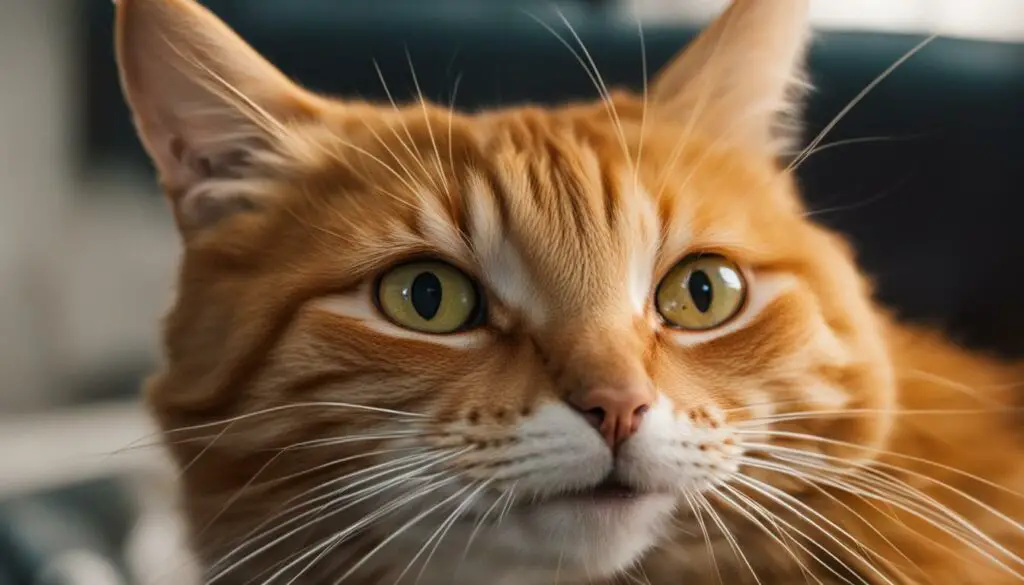
Remember, sudden biting when petting is not a sign of aggression but rather a communication from your cat that she needs a break. By being attentive to her body language and providing her with the appropriate space and environment, you can strengthen your bond with your cat and ensure that your interactions are enjoyable for both of you.
Love Bites
Love bites are a common behavior displayed by cats to express affection towards their human companions. These gentle nibbles or bites are reminiscent of how a mother cat grooms her kittens with small bites. It’s their way of including us in their family and strengthening the bond between feline and human. So, if your cat gives you a love bite, don’t be alarmed!
Love bites can happen during moments of close interaction, such as when you’re petting or cuddling your cat. They are usually gentle and accompanied by purring or rubbing against you. It’s a positive form of communication that signifies your cat’s affection and trust. However, it’s important to note that each cat has its own threshold for love bites, and it’s crucial to pay attention to their body language and respect their boundaries.
When your cat gives you a love bite, it’s essential to respond appropriately. Avoid sudden movements or pulling away, as it may startle your cat and lead to unintended scratches. Instead, stay calm and gently withdraw your hand or redirect their attention to a toy or scratching post. By doing so, you reinforce positive behavior and teach your cat boundaries for expressing affection.
| Benefits of Love Bites | How to Respond |
|---|---|
| Strengthens the bond between cat and human | Stay calm and avoid sudden movements |
| Signifies trust and affection | Withdraw your hand gently |
| Promotes positive communication | Redirect their attention to a toy or scratching post |
“Love bites are a cat’s way of saying ‘I love you’ and including you as part of their family.”
Understanding Your Cat’s Grooming Behavior
Love bites can also be seen as a form of grooming behavior. Cats groom each other as a way to bond and show affection within their social groups. When your cat gives you a gentle bite, they are replicating this behavior and treating you like a member of their feline family. It’s a way for them to make you feel comfortable and accepted.
By reciprocating your cat’s affection with gentle petting and offering them plenty of social interaction, you strengthen the love and trust between you. Remember, each cat is unique, and their love bites may vary in intensity. Pay attention to their body language, and always respond with patience, understanding, and respect.
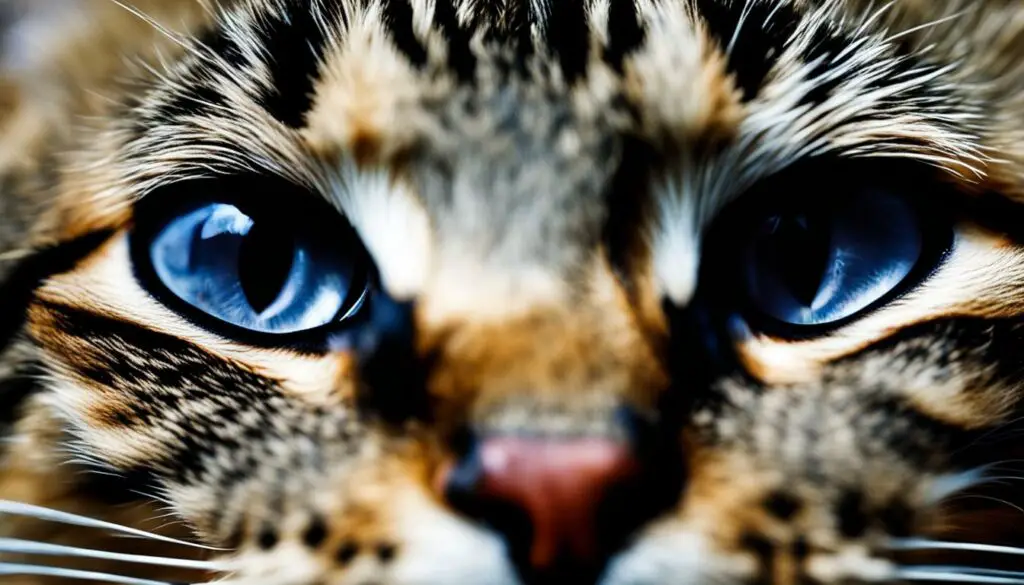
Aggressive Biting
Aggressive biting is a more serious form of biting and is often accompanied by aggressive body language, such as hissing or defensive posturing. It is essential to recognize the warning signs and avoid situations that may cause defensive fear in cats. Punishment is not recommended, as it may worsen the behavior. Seeking advice from a qualified feline behaviorist is advisable for frequent or unexplained aggressive biting.
When a cat displays aggressive biting behavior, it may be a result of feeling threatened or defensive. It’s important to understand that cats have different thresholds for stimulation and may become overstimulated or overwhelmed during petting or handling. Recognizing the warning signs such as dilated pupils, ears flattened back, growling, or tail flicking can help prevent aggressive biting incidents.
It is crucial never to physically punish or yell at a cat exhibiting aggressive biting behavior. This may escalate the aggression and damage the trust between you and your cat. Instead, create a safe environment to minimize potential triggers and consult a professional to develop a behavior modification plan tailored to your cat’s specific needs.
Warning Signs of Aggressive Biting:
- Rapid tail flicking or lashing
- Pinned-back ears
- Hissing or growling
- Intense staring
- Puffed-up fur
By understanding the body language and warning signs associated with aggressive biting, cat owners can take the necessary steps to prevent or manage this behavior. It’s important to create a safe and stress-free environment for the cat, minimizing potential triggers that may lead to defensive aggression. Seeking professional guidance from a feline behaviorist can provide valuable insights and strategies to address and modify the aggressive biting behavior.
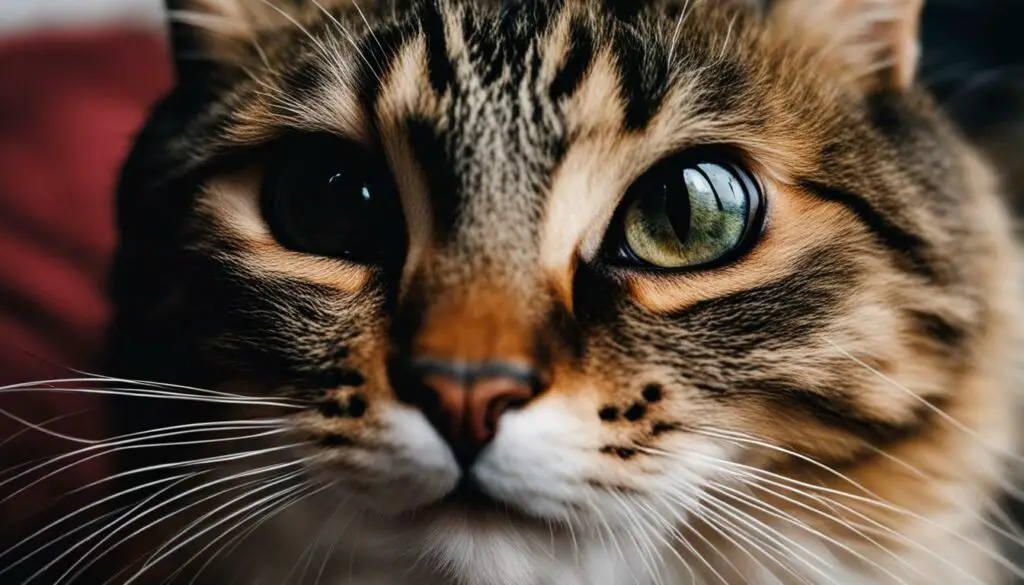
| Signs of Aggressive Biting | Prevention and Management |
|---|---|
| Rapid tail flicking or lashing | Provide a calm and predictable environment for the cat. Avoid sudden movements or loud noises that could startle them. |
| Pinned-back ears | Respect the cat’s personal space and body language. Avoid petting or approaching them when they display defensive signals. |
| Hissing or growling | Give the cat time and space to calm down. Do not force interactions or handle them when they are displaying aggressive behavior. |
| Intense staring | Avoid direct eye contact, as it can be perceived as a threat by the cat. Redirect their attention to toys or other objects to distract them from aggressive behavior. |
| Puffed-up fur | Allow the cat to retreat to a safe space where they feel secure. Provide hiding spots and vertical spaces to help alleviate stress and anxiety. |
Know Your Cat!
Understanding your cat’s behavior is key to building a strong bond and preventing biting incidents. Cats have their own unique body language and subtle signals that can help us interpret their needs and emotions. By observing and understanding these cues, we can create a safe and harmonious environment for our feline companions.
Cat behavior is influenced by a variety of factors, including their genetics, past experiences, and individual personality. By spending time with your cat and paying attention to their body language, you can gain valuable insights into their preferences and boundaries. For example, a cat with their tail held high and ears forward generally indicates a friendly and relaxed mood, while a tucked tail and flattened ears may signal fear or aggression.
Additionally, cats communicate through various vocalizations, such as purring, meowing, and hissing. Each sound carries its own meaning and can provide valuable information about your cat’s emotional state. Learning to recognize and respond to these vocal cues can help prevent misunderstandings and potential biting incidents.
Remember, understanding your cat’s psychology is an ongoing process that requires patience and observation. By familiarizing yourself with their unique behaviors and communicating with them in a way they understand, you can strengthen your bond and create a loving and bite-free relationship.
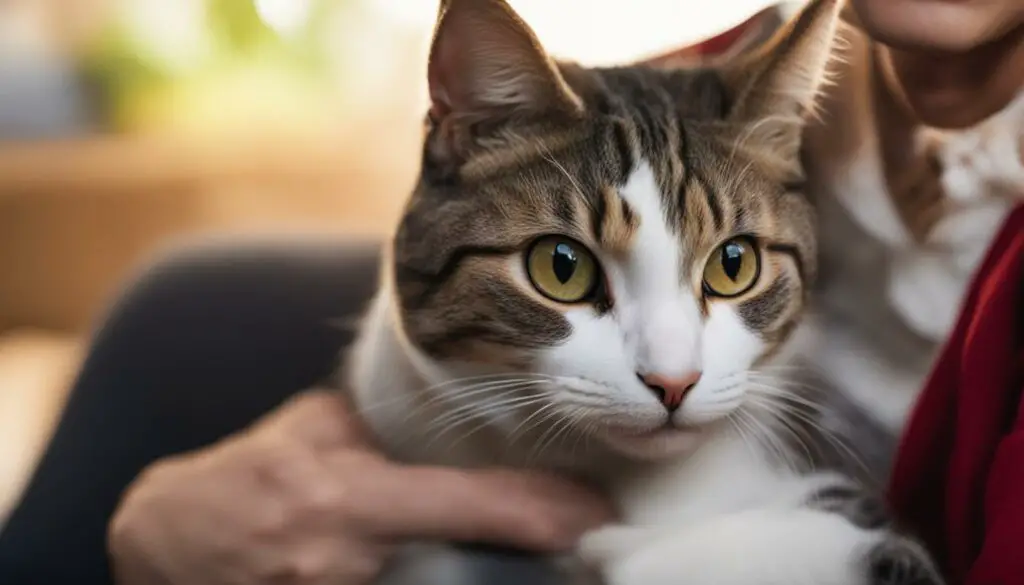
Health Check
When dealing with petting-related biting, it’s crucial to consider the possibility of underlying medical issues that may contribute to this behavior. Before assuming that your cat’s biting is purely behavioral, it is important to consult with a veterinarian to rule out any potential health concerns.
Medical issues such as dental problems, skin sensitivities, or musculoskeletal pain can cause discomfort or pain when touched, leading to a defensive response from your cat. By addressing and treating these underlying health issues, you may be able to alleviate or manage the biting behavior more effectively.
During the health check, the veterinarian will conduct a thorough examination to identify any potential medical problems. They may also recommend additional tests or diagnostic procedures, such as bloodwork or imaging, if necessary. Once any medical issues have been addressed, you can then focus on addressing the behavioral aspects of the biting behavior.
| Signs of Underlying Health Issues |
|---|
| 1. Limping or favoring a particular body part |
| 2. Changes in appetite or weight loss |
| 3. Excessive grooming or hair loss |
| 4. Swollen or painful areas on the body |
| 5. Changes in litter box habits (e.g., urinating outside the litter box) |
Remember, a thorough health check is essential in ensuring the well-being of your cat and addressing any potential medical issues that may contribute to petting-related biting behavior.
References:
- First source: Link to the first source
- Second source: Link to the second source
- Third source: Link to the third source
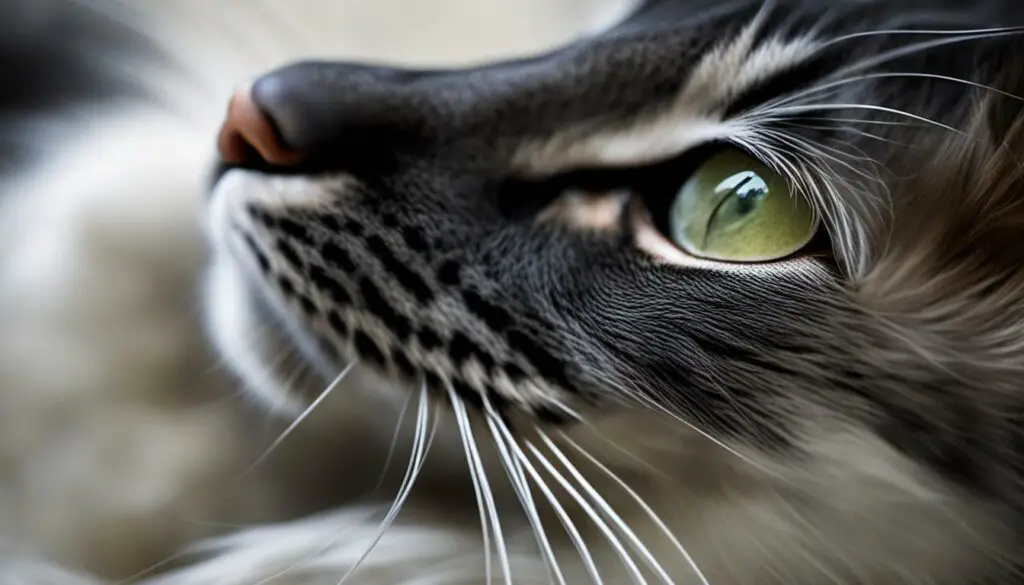
Signs of Petting-Related Aggression
When it comes to petting-related aggression, cats often provide warning signs before they resort to biting. These signs may be subtle or quick, but if we pay close attention to our cat’s body language, we can anticipate and avoid situations that trigger this behavior.
Cats that are reaching their limits of tolerance may show signs such as tensing their body, wagging their tail rapidly, or quickly turning their head away. These behaviors serve as clear signals that they are feeling uncomfortable and need a break from petting. It’s important to respect these signs and give them the space they need to relax.
To better understand your cat’s body language and prevent petting-related aggression, here are some key warning signs to look out for:
- Stiff or tense body posture
- Flattened ears
- Tail twitching or wagging rapidly
- Dilated pupils
- Growling or hissing
- Attempts to move away or escape
By recognizing these warning signs, we can adjust our behavior accordingly and avoid pushing our cat beyond their comfort zone. Remember, every cat has their own unique boundaries and preferences, so it’s essential to observe and respect their individual needs.
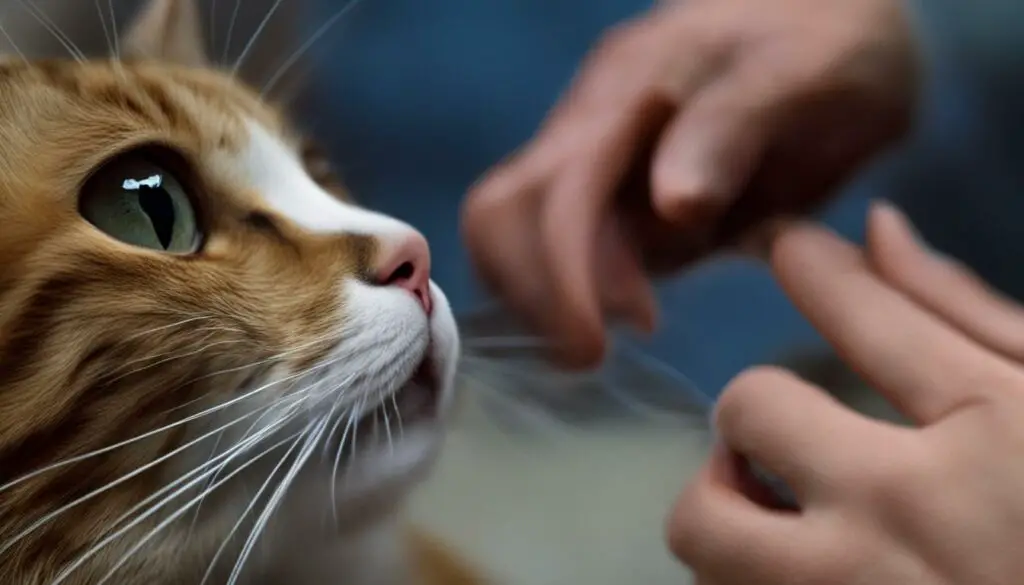
Understanding Your Cat’s Body Language
In addition to the specific warning signs mentioned above, it’s helpful to familiarize yourself with your cat’s overall body language. This will enable you to better interpret their emotions and respond appropriately in various situations.
For example, a relaxed and content cat may have a loose and relaxed body posture, soft eyes, and gently flicking tail. On the other hand, an anxious or agitated cat may exhibit a tense body, dilated pupils, and a lashing or puffed-up tail.
Take the time to observe and learn your cat’s body language cues so that you can better understand their needs and prevent petting-related aggression. This knowledge will not only help you build a stronger bond with your furry friend but also create a safer and more enjoyable environment for both of you.
How to Stop Petting-Related Biting
Dealing with petting-related biting can be challenging, but with the right approach, it is possible to address and prevent this behavior. Here are some effective strategies:
- Redirection: If you notice your cat becoming agitated or displaying signs of overstimulation while being petted, gently redirect their attention to a toy or interactive puzzle feeder. This helps shift their focus away from biting and encourages more appropriate behavior.
- Positive reinforcement: Reward your cat for calm and gentle behavior during petting sessions. After a successful petting session, offer a treat or engage in playtime to reinforce positive associations with being touched.
- Gradual desensitization: If your cat has specific areas where they are more prone to biting during petting, gradually desensitize them to touch in those areas. Start by touching the area briefly and reward your cat with a treat. Gradually increase the duration and intensity of touch over time, always monitoring your cat’s comfort levels.
- Handling techniques: Use gentle and slow petting strokes to help your cat feel more relaxed. Avoid rough or sudden movements that may startle them. Pay attention to their body language and immediately stop petting if you notice any signs of discomfort or agitation.
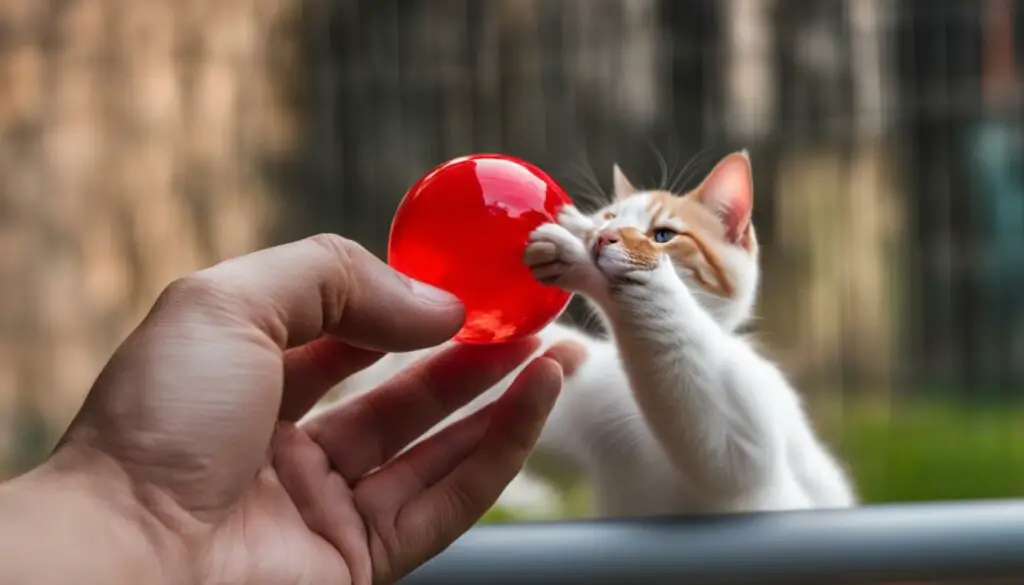
“Positive reinforcement is key in teaching your cat appropriate behavior. By rewarding calm and gentle behavior, you are more likely to see a decrease in petting-related biting.”
Summary
Addressing petting-related biting requires patience, understanding, and positive reinforcement. By redirecting your cat’s attention, rewarding good behavior, gradually desensitizing sensitive areas, and using gentle handling techniques, you can help your cat develop more appropriate responses during petting sessions. Remember to always observe your cat’s body language and provide a safe and comfortable environment for interaction.
Why Does My Cat Bite Me?
Cats may bite for various reasons, including fear, aggression, or affection. Understanding the specific motivation behind each bite is crucial in responding appropriately. Differentiating between types of biting behaviors can help cat owners address the underlying issues and prevent unnecessary negative interactions.
When a cat bites out of fear, it is usually due to feeling threatened or cornered. Cats are naturally cautious creatures, and they may resort to biting as a way to protect themselves. It’s important to create a safe and calm environment for your cat, allowing them to feel secure and reducing their fear-induced biting tendencies.
Aggressive biting, on the other hand, can occur when a cat feels provoked or territorial. This type of biting is often accompanied by defensive body language, such as hissing or flattening their ears. Understanding the warning signs and avoiding situations that trigger aggression can help prevent these types of bites.
Lastly, some cats may bite as a form of affectionate communication. This behavior, known as love bites, is reminiscent of how a mother cat grooms her kittens with gentle nibbles. Love bites are usually harmless and can be seen as a demonstration of trust and bonding. It’s important to recognize the context and body language associated with the bite to determine if it is an affectionate gesture or not.
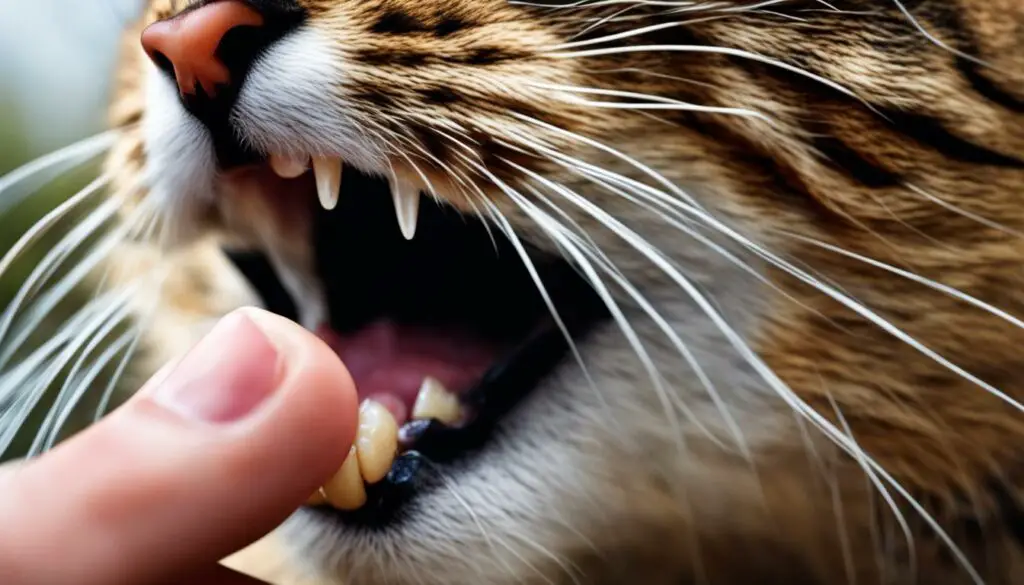
Fear Biting
When a cat bites out of fear, it is usually due to feeling threatened or cornered. Cats are naturally cautious creatures, and they may resort to biting as a way to protect themselves. It’s important to create a safe and calm environment for your cat, allowing them to feel secure and reducing their fear-induced biting tendencies.
Aggressive Biting
Aggressive biting can occur when a cat feels provoked or territorial. This type of biting is often accompanied by defensive body language, such as hissing or flattening their ears. Understanding the warning signs and avoiding situations that trigger aggression can help prevent these types of bites.
Affectionate Biting
Some cats may bite as a form of affectionate communication. This behavior, known as love bites, is reminiscent of how a mother cat grooms her kittens with gentle nibbles. Love bites are usually harmless and can be seen as a demonstration of trust and bonding. It’s important to recognize the context and body language associated with the bite to determine if it is an affectionate gesture or not.
How to Stop Cat Bites
If you’re dealing with cat bites or want to prevent them from happening in the first place, there are several steps you can take. First and foremost, it’s crucial to have regular veterinary check-ups to ensure your cat is in good health. Sometimes, medical issues can contribute to biting behavior, so ruling them out is essential. A healthy cat is more likely to exhibit positive and non-aggressive behavior.
Another important aspect is behavior deterrence. Providing appropriate toys and mental stimulation for your cat can help redirect their biting instincts towards more suitable objects. Interactive play sessions can satisfy their hunting needs and prevent them from redirecting their playful bites towards humans. Remember, a tired cat is a well-behaved cat!
Observing and respecting your cat’s body language is also crucial in preventing cat bites. Cats often give subtle signals before they bite, such as tensing their body, wagging their tail, or quickly turning their head. By recognizing these warning signs, you can avoid situations that may trigger their aggression. Understanding your cat’s specific cues and preferences is key in maintaining a harmonious relationship.
Lastly, if you’re struggling to address biting behavior or unsure how to handle it, don’t hesitate to seek veterinary consultation or advice from a qualified feline behaviorist. They can provide personalized guidance and support based on your cat’s specific needs and circumstances. A professional’s expertise can help you develop effective strategies and techniques to stop cat bites and create a safe and loving environment for both you and your furry friend.
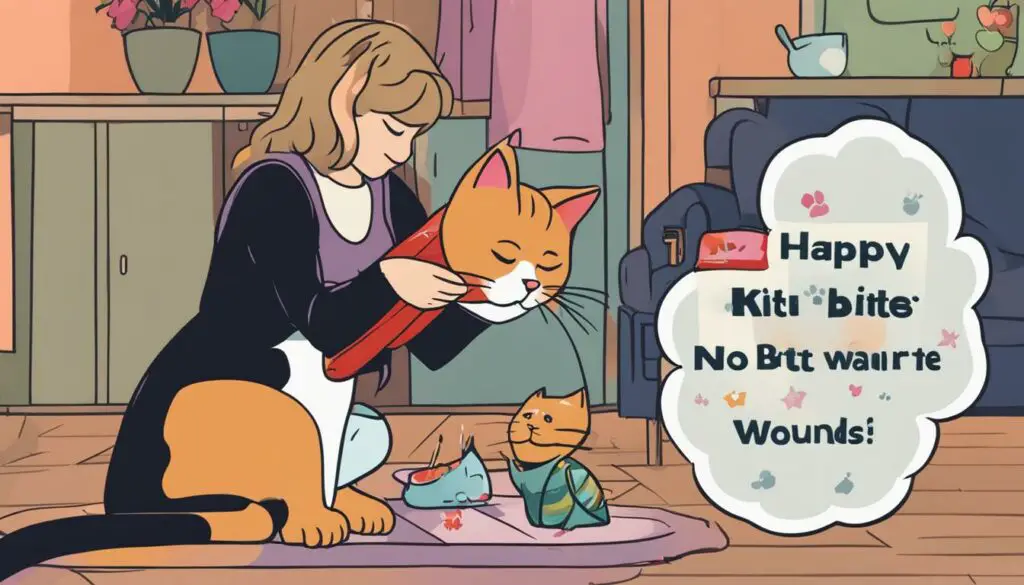
| Preventive Measures | Benefits |
|---|---|
| Regular veterinary check-ups | Identify and address any underlying medical issues that may contribute to biting behavior. |
| Provide appropriate toys and mental stimulation | Redirect biting instincts towards more suitable objects and prevent the redirection of playful bites towards humans. |
| Observe and respect your cat’s body language | Recognize warning signs and avoid situations that may trigger aggression. |
| Seek veterinary consultation or behaviorist advice | Get personalized guidance to address biting behavior effectively and create a safe environment. |
Conclusion
In conclusion, understanding the reasons behind cat biting and how to prevent it is essential for maintaining a harmonious relationship with our feline companions. Cats may bite for various reasons, including fear, aggression, or even as a sign of affection. By differentiating between types of biting behaviors and addressing them appropriately, cat owners can create a loving and bite-free environment.
Prevention is key when it comes to cat biting. Regular veterinary check-ups to rule out any underlying medical issues, providing appropriate toys and mental stimulation, and observing and respecting your cat’s body language are all important steps in preventing biting incidents. Additionally, seeking professional advice from a qualified feline behaviorist can be beneficial if the biting behavior persists or becomes a frequent occurrence.
Remember, maintaining a calm and consistent approach is crucial in building a strong and trusting bond with your cat. Avoid negative reactions such as hitting or yelling, and instead focus on positive reinforcement and redirection techniques. By taking proactive measures to understand and address your cat’s behavior, you can create a safe and fulfilling interaction between humans and cats.
FAQ
Why does my cat bite me when I stop petting her?
This behavior is not uncommon and is often not a sign of true aggression. Understanding the reasons behind this behavior can help cat owners avoid it and better interpret their cat’s subtle signals.
Why do kittens bite?
Kittens naturally engage in biting behavior as part of their play and learning process. They explore their world by biting and nipping, practicing their hunting skills, and relieving teething pain. It’s important for kitten owners to provide appropriate toys and playtime to redirect this behavior.
Do adult cats engage in play biting?
Yes, adult cats also engage in play biting. Cats use play biting to communicate and mimic hunting behaviors. It’s essential for cat owners to provide appropriate toys and play opportunities to satisfy their cat’s need for play and prevent them from redirecting their playful bites towards humans.
Why does my cat bite me suddenly when being petted?
Sometimes cats may bite when being petted suddenly. This behavior is often a result of overstimulation and is not intended as true aggression. Cats may exhibit subtle warning signs, such as tail swishing, staring, or ear flattening, before biting. Learning to read these signals can help cat owners prevent bites while petting.
Why does my cat gently nibble or bite me?
Some cats may gently nibble or bite their owners as a sign of affection. This behavior is reminiscent of how a mother cat grooms her kittens with small bites. Love bites are usually harmless, and cats may exhibit this behavior to show their affection and include their human as part of their family.
What should I do if my cat exhibits aggressive biting?
Aggressive biting is a more serious form of biting and is often accompanied by aggressive body language, such as hissing or defensive posturing. It is essential to recognize the warning signs and avoid situations that may cause defensive fear in cats. Punishment is not recommended, as it may worsen the behavior. Seeking advice from a qualified feline behaviorist is advisable for frequent or unexplained aggressive biting.
How can I understand my cat’s body language?
Understanding your cat’s body language and preferences is crucial in preventing biting behaviors. Cats may have individual variations in their behavior, and spending time observing your cat’s specific cues can help you better understand their needs and avoid overstimulation or aggression.
Should I consult a veterinarian for petting-related biting?
Before addressing petting-related biting, it is important to consult a veterinarian to rule out any potential underlying medical issues that may contribute to this behavior. Identifying and addressing any medical problems can help alleviate or manage the biting behavior appropriately.
What are the warning signs of petting-related aggression?
Cats that exhibit petting-related aggression often give warning signs before they bite, although these signs may be subtle or quick. Recognizing signs such as tensing the body, wagging the tail, or quickly turning the head can help cat owners anticipate and avoid situations that trigger petting-related aggression.
How can I stop petting-related biting?
To address petting-related biting, it is essential to deter or redirect the behavior. This can be done by avoiding petting in specific areas that cause aggression, gradually increasing the cat’s tolerance for touches in those areas, and reinforcing positive associations with treats. Handling the cat gently and avoiding negative reactions such as hitting or yelling is crucial in building trust and preventing further aggression.
Why do cats bite?
Cats may bite for various reasons, including fear, aggression, or affection. Understanding the specific motivation behind each bite is crucial in responding appropriately. Differentiating between types of biting behaviors can help cat owners address the underlying issues and prevent unnecessary negative interactions.
How can I prevent cat bites?
It is important to take proactive steps to prevent cat bites. This includes regular veterinary check-ups to rule out medical issues, providing appropriate toys and mental stimulation, observing and respecting your cat’s body language, and seeking professional advice if necessary. Avoiding negative reactions and maintaining a calm and consistent approach is key in building a strong and trusting bond with your cat.

